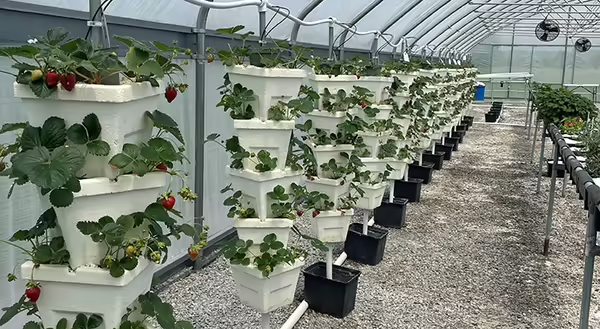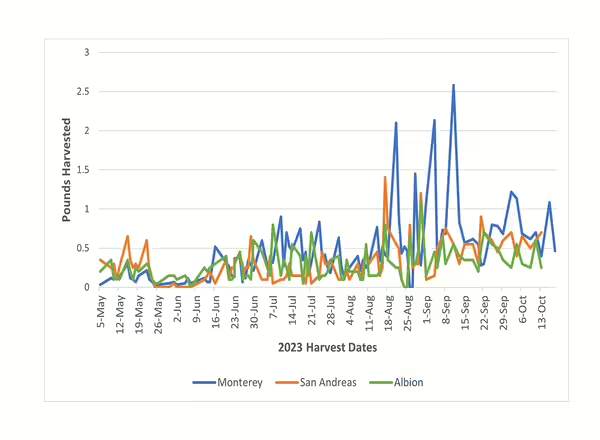
Hydroponic production allows for different configurations or growing systems that can include gutters, rails, troughs, buckets, slabs, and bags, as well as different substrates or growing media including perlite, coconut coir, rockwool, and more. Couple production system versatility with controlled environmental conditions, it becomes easy to see how a hydroponic system could be a fit for off-season production, providing more fresh produce into the local food systems year-round.
With no external heat source or additional lights, our designated hydroponic high tunnel is in production just through three seasons, beginning in mid-March and ending sometime in October (depending on the first major frost/freeze event of the fall). This tunnel serves as a demonstration of multiple growing systems and provides observational information only on the different crops. For this reason, most of the crops are not being grown under their ideal parameters, especially regarding nutrient solution and temperature, as all the crops are fed from the same fertigation system.
Strawberries in hydroponic tunnels
One of the consistent crops grown in the hydroponic tunnel at the Dixon Springs Agricultural Center in southern Illinois has been strawberries. By planting strawberry plants into the vertical stack growing system, square footage within the high tunnel is maximized while also efficiently utilizing more of the controlled environment conditions created within the structure.
Planting and care
Dormant bare root plants are received in February, grown out 2-3 weeks in the greenhouse and transplanted into the perlite filled styrofoam cubes of the stack system.
- The fertigation system is set to deliver about a minute of nutrient solution per hour, which can be adjusted as needed based on plant growth, fruit set and environmental conditions (temperature, sunlight).
- Electrical conductivity or EC is generally held to around 1.8 millisiemens/cm and a pH of 6.6.
- The general nutrient solution composed of 3-15-28 at 1 lb/gallon and calcium nitrate 15.5-0-0 at 0.5 lb/gal is used across of the crops in the tunnel.
- A shade cloth is stretched over the tunnel the first of June to help lower temperatures.
- This tunnel has fixed side walls and relies on exhaust fans to pull outside air through the tunnel to help with cooling and humidity.
Varieties
In previous years, only one variety was grown in the 15 vertical stacks, but during the 2023 season, three day-neutral strawberry varieties were planted: ‘Monterey,’ ‘San Andreas,’ and ‘Albion.’ ‘Albion’ is a common variety used in hydroponic production as it is known to produce consistently large, flavorful fruit, although yields tend to be lower than other varieties. In past years, ‘Monterey’ had better flavor than ‘San Andreas’ in our production setup. It should be noted that these plants are being grown in the hottest time of the year in southern Illinois inside a high tunnel, and production is expected to be lower than the potential each of these varieties could reach if grown in more ideal conditions.
Yields
Observational yield data collected from the three day-neutral strawberry varieties evaluated during the 2023 growing season includes:
- ‘Monterey’ was the highest yielding with 0.76 lbs/plant of marketable fruit
- ‘San Andreas’ had the largest average fruit size at 28.7 fruit/lb and the second highest yielding at 0.54 lbs/plant
- ‘Albion’ was the lowest yielding with 0.48 lbs/plant, which was expected, but it also produced on average the smallest fruit at 42.8 fruit/lb, which is surprising as this variety is known for producing large fruit
- ‘Monterey’ had the best flavor, followed closely by ‘San Andreas’ and ‘Albion’ tended to be a bit on the sour side
- ‘San Andreas’ is ripening to a deeper red with the onset of cooler temperatures when compared to fruit quality during the summer

Yield data was collected from 100 harvests that started on May 5 and concluded on October 18. Starting the middle of August, an increase in yield was observed in all three varieties with ‘Monterey’ producing more fruit and for a longer duration than the other two varieties, displaying a yield spike for about 4 weeks. ‘San Andreas’ showed a bit higher spike in yield than the other two varieties very early in the season from around May 15 to May 25. Yield really fell off for all three varieties from the end of May to around the middle of June when a slight uptick was observed. Figure 1 provides a good visual of the yield trends or spikes across the 2023 harvest season. While data collection ended on October 18, all varieties are still producing and fruit quality has improved with the onset of cooler weather.
Special thanks to Indiana Berry & Plant Co. for donating the strawberry plants in support of our continued demonstration and research trials at the University of Illinois Dixon Springs Agricultural Center.
Photo: Day-neutral strawberries varieties grown in vertical stack system at the Dixon Springs Agricultural Center during first week of May at the first harvest of the 2023 season. Photo credit: B. Aly Illinois Extension 2023.